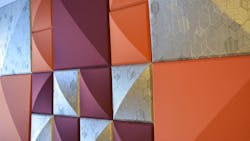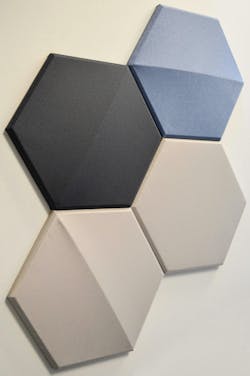Have You Heard? Acoustic Treatments Can Look Good, Too
When building owners and facility managers think about adding acoustic treatments to interior spaces, their imaginations no longer need to stop at nondescript panels. Today's acoustic treatments offer a variety of colors, shapes, and fabrics that can easily complement existing spaces as well as inspire new ones. Acoustic product manufacturers are also finding ways to make high-end looks and high-quality fabric facings more affordable, allowing virtually any building space to look as good as it sounds.
For those tasked with adding acoustic treatments to spaces or addressing acoustics in new buildings, it’s time to take a fresh look, and listen, to what these elements have to offer.
Where Acoustic Treatments (Quietly) Sing
Individual spaces in a building function successfully when they prioritize occupant needs. In the context of sound, these needs may be for quality and clarity, dampening to diversify space without disruption, minimizing transmission to protect personal or professional privacy, or all of these and more.
Historically, buildings relied on features like ceiling heights, flooring materials, and soft furnishings to direct and diffuse sound, but our modern needs for sound management are notably more nuanced. Now, acoustic treatments must tend to a confluence of considerations, from individual sound sensitivity to legal requirements for privacy. Some examples of where and why acoustic treatments are now prioritized in buildings include:
- Corporate offices to reduce noise pollution and enhance speech clarity, especially in open-plan offices and meeting rooms.
- Educational facilities to create environments conducive to learning by minimizing echoes and background noise in classrooms, lecture halls, and libraries.
- Healthcare facilities to improve patient comfort and privacy by dampening noise in check in/check out areas, patient rooms, waiting rooms, and consultation areas.
- Hospitality and retail spaces to add ambiance, soften sound, and enhance the customer experience in restaurants, hotels, and stores.
As acoustic science and technology have evolved to serve applications like these, design has also come aboard to help sound products better blend with the aesthetics of these contexts. With a new generation of design options, acoustic treatments can now do as much for how a space looks as for how a space sounds.
A New Era of Acoustic Design
Those utilitarian-looking acoustic panels of the past? They’ve gotten a double-take makeover. Today's acoustic treatments come in a multitude of shapes, sizes, colors, and fabric facings and include options that work within just about any budget. Here’s a look at what’s now offered:
- Endless Shapes: In addition to rectangular panel shapes, acoustic elements now include contoured and 3D shapes in standard and custom sizes. Using shapes to create patterns is a great option for adding movement and flow throughout a building and for communicating the intended use of a space. Shapes include hexagons, circles, diamonds, squares, and scales with beveled or square edges that can take the look of a space anywhere, from soft and playful to serious and focused.
- Fabrics Galore: Acoustical panel and diffuser facings offer endless patterns and textures, allowing interior designers to select optimal combinations to complement broader aesthetics as well as enhance sound. New lightweight, tight-weave fabrics from select manufacturers, for instance, provide good acoustical transparency and an attractive appearance at an affordable price. Other options include sustainable, post-consumer recycled fabrics and fabric blends, felt fabrics, polyester, and more.
- Vibrant Colors: Fabric facings and other finishes offer a broad color palette that includes custom colors and color-matching options. This gives building owners and facility managers the freedom to merge acoustic treatments with existing décor for a cohesive design. Color matching is also a popular choice for communicating corporate identity, and it’s a simple way to designate spaces for different purposes and to direct occupants to specific areas within a building.
These diverse design options enable acoustic treatments to serve as both functional and decorative elements, contributing to the visual appeal of a space while serving the practical purpose of controlling sound.
Communicating With Acoustic Elements
Just like signage in a building uses shapes, colors, and patterns to guide behavior or direct traffic, acoustic elements can deliver these same visual cues while also contributing to sound quality. With so many shapes and colors available, different areas of a building can use acoustic treatments to communicate. For example:
- Professionalism and sophistication: In corporate settings, sleek and modern acoustic panels can reinforce a company’s focus on quality and attention to detail.
- Creativity and innovation: Brightly colored, uniquely shaped panels in creative workspaces can stimulate imagination and inspire creativity.
- Warmth and comfort: In healthcare buildings or residential environments, soft, muted tones and fabrics can create a sense of calm and relaxation.
Thoughtful selection of colors, shapes, and fabrics and considerate placement of acoustic treatments are simple ways to impact the atmosphere and the user experience on multiple levels.
Other Advantages of Acoustic Treatments
Beyond sound enhancement and aesthetics, modern acoustic treatments offer several other benefits that may be new to building owners and facility managers. These include:
- Online Tools: Some manufacturers also offer online tools that invite you to input your project or space details, select acoustical products, and download custom specs and save files for future use.
- Easy Installation: Installation systems like fully concealed wall-mounted impaling clips and hook-and-loop fasteners make it easier to affix certain acoustic treatments, in some cases without professional help.
- LEED Credit: Some acoustic treatments contribute to Leadership in Energy and Environmental Design (LEED) credits, supporting sustainable building practices.
- Indoor Air Quality: Some acoustic products meet GREENGUARD Children & Schools Certification and California Title 24, ensuring low VOC emissions and contributing to healthier indoor environments.
- Fire Safety: Products certified to Class 1/A, UL 723/ASTM E84 standards offer reliable fire resistance and add to the safety of the spaces where they’re used.
These additional advantages highlight how modern acoustic treatments contribute to a broader improvement in building functionality, safety, and sustainability.
Acoustics Should Be Seen and Heard
The evolution of acoustic elements from flat, unremarkable panels to colorful, dimensional design elements marks a significant advancement in the relationship between acoustic treatment and interior design. As sound considerations are increasingly included in the early stages of space planning, environments can achieve optimal acoustic comfort while also meeting other needs for how a space looks and feels and what it communicates.
With a wide range of designs, customization options, and additional benefits like sustainability certifications, acoustic treatments are essential for creating comfortable, appealing environments that are equally effective when seen as when heard.
About the Author
Charles Carrender
Charles Carrender, National Sales Manager at AVL Systems Inc., specializes in the field of architectural acoustics and sound system integration. His 15 years of expertise in understanding the nuances of sound in architectural spaces has been pivotal in driving new market developments for large commercial construction spaces and projects. Charles combines business strategy with customized client engagement to address the unique acoustic requirements of diverse environments.

